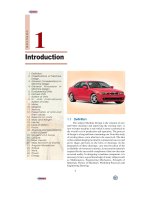- Trang chủ >>
- Khoa Học Tự Nhiên >>
- Vật lý
Text book earth friendly planet
Bạn đang xem bản rút gọn của tài liệu. Xem và tải ngay bản đầy đủ của tài liệu tại đây (3.8 MB, 62 trang )
Learn Who You Share This
Beautiful Planet With!
This e-book gives simple profiles of earth’s countries, focusing on environment and
wildlife. Find out about neighbouring friends (human or otherwise) in:
Africa
Antarctica
Asia
Europe
North America
Oceania
South America
Website
When you have read this e-book, you will be so in love with our planet that
presumably you will want to help to save it! Visit www.earthfriendlyplanet.com to
find a library of useful websites and recommended books.
Copyright © Community Press 2010
Table of Contents
Africa ................................................................................................. 3
North Africa....................................................................................................................... 3
East Africa ......................................................................................................................... 5
Central Africa .................................................................................................................... 7
West Africa ........................................................................................................................ 8
Southern Africa ............................................................................................................... 12
South East ....................................................................................................................... 13
Antarctica ........................................................................................ 15
Asia ................................................................................................. 18
Eastern Asia .................................................................................................................... 18
Western Asia ................................................................................................................... 23
Middle East ..................................................................................................................... 25
Europe............................................................................................. 29
The Isles .......................................................................................................................... 29
Northern Europe ............................................................................................................. 31
Central Europe ................................................................................................................ 33
Southern Europe ............................................................................................................. 35
Eastern Europe ............................................................................................................... 37
www.earthfriendlyplanet.com
1 of 59
North America ................................................................................ 43
The 3 Northern Countries ............................................................................................... 43
Central America .............................................................................................................. 44
Caribbean Islands ........................................................................................................... 46
Oceania ........................................................................................... 51
The Big Islands ................................................................................................................ 51
The Small Islands ............................................................................................................ 52
South America ................................................................................ 57
www.earthfriendlyplanet.com
2 of 59
Africa
This contrasting land includes hot desert in the north, to swampy rainforest in
the south. As it lies near the Equator, there are only two seasons – dry and wet!
The proximity to the Equator also brings quicker sunrises and sunsets – often it
goes straight from day to night.
North Africa
Algeria
Most of this large country is covered by the Sahara Desert – home to just a few creatures
like monitor lizards and sand vipers. Also here live native tribes like Berbers and Tuaregs
(called ‘indigo people‘ due to their skin being stained from their dark blue robes). The
national dish is couscous, always finished with sweet mint tea.
Djibouti
Like most eastern countries, this is set in The Horn of Africa (a peninsula that juts out into
the Arabian sea). Again it‘s mainly desert, but it also sits on the Red Sea (its name comes
from the red-coloured plants near the surface), the most northern tropical sea on earth.
www.earthfriendlyplanet.com
3 of 59
Egypt
Home to the Nile (the world’s longest river) and the mysterious Giza pyramids (built on
exact cardinal points), the chaotic capital city of Cairo (Um ad-Dunya – ‘mother of the
world’) contains 20 million people. A land of friendly camels (they only spit if distressed),
ancient cats and hungry crocodiles.
Eritrea
This green country has almost 700 miles of protected coastline along the Red Sea. If
families have leftover Sowa (a fermented barley drink), they place a tin can on a long stick in
front of their house, so others can share. If you take coffee, expect an hour’s wait – and you
are expected to drink three cups!
Libya
This country in the Sahara desert holds the record for the hottest ever temperature
recorded, but it is cooler by the Mediterranean Sea. The town of Ghadames has been
cleverly built with interconnected white buildings, to keep people cool. The Jebel Acacus
mountains contain cave art dating back 12,000 years.
Mauritania
Not to be confused with Mauritius, this lies on the Atlantic Ocean. Like most northern
countries, it is nearly all desert and also contains Ben Amera, the second biggest monolith
(sandstone) after Australia’s Uluru.
Western Sahara
Presently shared by Morocco and Algeria, this small country is mostly made up of Sahara
desert, and borders the Atlantic Ocean. It is home to some of the most inhospitable land on
earth.
www.earthfriendlyplanet.com
4 of 59
Morocco
Just across the sea from Spain, this is a different world of hot desert, Berber tribes and the
Atlas and Rif mountains. The urban areas are a heady mix of souk markets, carpet sellers,
hot mint tea and the city of Casablanca. Morocco is known for its beautiful Moorish
gardens, orange trees, flamingos, grey cranes, herons and storks.
Sudan
This is the largest country in Africa, divided by the Nile and bordered by the Red Sea. It has a sad
history of civil war (Darfur), but now looks to peace. It contains the Nubian Desert, swamps and
rainforests. Here once roamed northern white rhinos (now strictly protected, to save the species).
Tunisia
Like Morocco, this is a land of colour and spice. Ornate front doors are often painted bright
blue to match the sky. This is the home of the ostrich – the world’s largest bird who is second
only to the cheetah in speed (he can use his wings as rudders to change direction mid-run).
East Africa
Ethiopia
This country is considered by many as the birth of civilisation. It is also home to the
birthplace of Emperor Haile Selassie, the founder of the Rastafarian religion. Now the
famine has gone, many parts are full of lush greenery, waterfalls and the villa-rich city of
Addis Ababa. It’s also the birthplace of Yirgacheffe coffee.
Kenya
Here you can find more wildlife than anywhere else in Africa, including the annual
wildebeest migration: lion, leopard, rhino, elephant, buffalo, giraffe, topi, gazelle, monkey,
hippo, crocodile, hyena, jackal, cheetah and zebra (they mingle together to confuse the
colour-blind lion!) Masai semi-nomads also roam these lands.
www.earthfriendlyplanet.com
5 of 59
Rwanda
This high altitude country is cooler, and home to the mountain ‘gorillas in the mist’ made
known by researcher Dian Fossey. Now over its sad genocide history, Kigali recently
became the first city in Africa to receive the Habitat Scroll of Honour for its urban
conservation model. It‘s also the first majority women government.
Somalia
With the longest coastline in Africa, precious spices and exotic nomads, this is a fascinating
place. Supermodel Waris Sirie (who fled to London from an arranged marriage and now lives
in Austria) continues to highlight the issue of female circumcision in her former homeland.
Tanzania
Known for its annual wildebeest migration near the Kenyan
border, this is where Dr Jane Goodall arrived 50 years ago to
study wild chimpanzees. Based on Lake Tanganyika, Tanzania
also lies on the Indian Ocean and is home to Mount
Kilimanjaro – Africa’s highest peak.
Uganda
Like Rwanda, its star attraction are the mountain gorillas,
hidden in inaccessible bamboo forests. Other flora and fauna
include African grey parrots and giant lobelia plants. Uganda
(and what is now Democratic Republic of Congo) was the
setting for the film African Queen.
Zanzibar
This tropical ‘spice island’ lies 25 miles off the coast, and grows nutmeg, cinnamon and
pepper. It is an oasis of sandy beaches and coral reefs, and contains few of the wild animals
found elsewhere in Africa. There are however several birds, butterflies and coral reefs. The
north of the island is lined with palm, coconut and banana trees.
www.earthfriendlyplanet.com
6 of 59
Central Africa
Central African Republic
Although desert, this land sits in the basin of the Ubangi River, which flows into the Congo
(the largest river after the Nile). Textbook Africa, with lowland gorillas, chimps, forest
elephants and bongos (large antelopes with red coats and spiralled horns). National
Geographic Magazine voted it the country least affected by light pollution.
Chad
Again mainly desert, but Lake Chad is the second largest wetland in Africa. Marshes attract
elephants, hippos, giraffes, wildebeest, lions, antelopes, chimps, birds, ducks and reptiles.
Lake Chad also provides 20 million people with the only water supply near the surrounding
Sahara desert.
Congo
Not to be confused with the Democratic Republic of Congo (next), this landlocked country
next door is home to 80% of the world’s wild chimpanzees, who live in dense inaccessible
forest. Also find one of Africa’s largest tropical ecosystems in Odzala National Park and
eastern lowland gorillas in local swamps.
Democratic Republic of Congo
The third largest country in Africa, here you can find just a small section of coastline, and
more thunderstorms than anywhere on earth. This country is so big, it is the same size as
France, Germany, Spain, Sweden and Norway put together!
Equatorial Guinea
This small comparatively wealthy country (by African standards) has islands and native
tribes, and is called ‘the Amazon of Africa’, due to its lush rainforests, mangroves and
shrubs growing in salty coast waters. Home to pygmy tribes and the world’s largest
‘Goliath’ frog (only found here and in Cameroon).
www.earthfriendlyplanet.com
7 of 59
West Africa
Benin
This colourful country is known for its painters. Like most West African countries, it’s home
to elephants, lions, monkeys, antelopes and hippos (‘river horses’). The African Baobab
‘upside down’ tree produces monkey bread fruit for animals and humans – mysteriously at
the end of its life, it thumps to the ground -and mysteriously disappears!
Burkina Faso
Its name meaning ‘‘land of the upright people’, the people here harvest local nere trees for
their black seeds, to make into stock cubes. The savannah is home to giraffes, the tallest
land animals who gain extra water through eating the tall shrubs that others cannot reach.
They share these branches with smaller animals, to provide mutual look-out posts.
Burundi
This small landlocked country sits on Lake Tanganyika (the second largest freshwater lake in
the world – and the world’s deepest). Burundi is also the starting point for the Nile – the
world’s longest river. Burundi is known for its birds: Trumpeter Hornbill, African Lemon
Dove, Handsome Francolin and the ShoeBill.
Cameroon
With beautiful coastline, rainforests, deserts and 200 languages, this country (a bit larger
than California) is Africa in a nutshell. Waza and Benoue National Parks are home to hippos,
lions, water buffalo, elephants and warthogs. The more remote Boubanjidda National Park
is home to lowland gorillas – fiercely protected by local tribes now it is feared their black
rhinos may have recently become extinct. In the Dja Reserve, you can find Bantus and
pygmy people living together in harmony. The forests and coasts are also home to exotic
fruits, including oranges, pineapples, coconuts, grapefruits, limes and bananas (herbs).
www.earthfriendlyplanet.com
8 of 59
Cape Verde
These volcanic islands off the west coast are home to the third largest population of sea
turtles in the world (after Oman and Florida). Breeding humpback whales and dolphins are
a common sight along the turquoise oceans. Also find unique birds: Alexander Swift, Raso
Lark, Lago Sparrow and Cape Verde Warbler.
Gabon
This stunning country is home to rainforests that extend to the sea, mangroves, Savannah
and the Cristal mountains. The president was so taken by photographer Mike Nicholl’s
pictures of ‘surfing hippos’, that he cancelled or bought out remaining logging. Also has
the second most whales and dolphins, after South Africa.
Gambia
This small country is less than 30 miles wide, and entirely surrounded by Senegal. It has 50
miles of Atlantic coastline, and is a dream destination for birds, with over 560 species. Also
home to hippos, baboons and rescued orphaned chimps, Gambia’s people are so friendly,
the country is known as ‘the smiling coast’.
Ghana
Bordered by the Ivory Coast, this is the most central country on earth (the exact centre is in
the Atlantic ocean). Trees abound here – baobabs, acacia, ebony, mahogany and shea. Wet
enough for elephants, monkeys, crocodiles and marine turtles, parrots and butterflies – also
hear one of the best dawn choruses in Africa.
Guinea Bissau
On the Atlantic Ocean, these islands hold mangrove swamps, powder white sand and azure
blue waters. It’s home to 5 of the world’s 8 tortoises, dolphins, manatees, crocodiles,
monkeys, striped antelope, 100 migratory birds and rare saltwater hippos. There is no
electricity here, so people sit in darkness and talk when evening falls.
www.earthfriendlyplanet.com
9 of 59
Guinea
Full of rainy and dry forests, this small country is teeming with wildlife. Add cascading
waterfalls, African elephants, otter-shrews and Diana monkeys (named after a goddess),
and this is the real spirit of Africa.
Ivory Coast
This is a square-shaped country on the Atlantic. It did suffer in the past from a severe toxic
spill. But today it is noted for its coconut palms and kola trees (the nuts help people to work
without fatigue, and clear the mind).
Liberia
The ‘Pepper Coast’ gets its name from the melgueta pepper and sits on the Atlantic
amongst mangrove forests. This country was founded for the purpose of providing a safe
free place for former slaves. Today it is a rainforest paradise and home to pygmy hippos,
deserted white beaches, tidal lagoons – and Africa’s first woman president.
Mali
This flat landlocked country lies mostly in the Sahara and includes the legendary city of
Timbuktu. It’s also home to desert elephants who have lived in harmony alongside native
tribes for centuries. The Dogon tribe realised that Jupiter had moons, Saturn had rings and
that the planets orbited the sun – all before the telescope was invented!
Niger
Not to be confused with Nigeria (next door), this adjacent country is again mainly covered
by the Sahara desert. It is home to endangered species like the African painted hunting dog
(whose coat literally looks like a palette of paint) and the wild addax antelope.
www.earthfriendlyplanet.com
10 of 59
Nigeria
With its port Lagos being one of the largest cities in the world, this is a big country, but it’s
not all urban. It’s home to tropical rainforest, the world’s largest diversity of butterflies and
the Drill Monkey – whose bottom is multi-coloured (pink, mauve and blue) which makes it
easy for his family to follow him through the forest!
Sao Tome and Principe
These quiet islands sit in the Gulf of Guinea, off the west coast. Here find the world’s
smallest ibis, the world’s largest sunbird and giant species of begonia. It looks more like the
South Pacific than Africa. At the beach, watch giant sea turtles come ashore to lay their
eggs, and humpback whales play.
Senegal
This Atlantic coastal country is the closest to the USA and completely surrounds the tiny
country of Gambia. This is bird paradise with many kingfishers (who eat their own
bodyweight in food each day) and millions of pink flamingos with their mesmerising mating
dance (their colour comes from algae they eat).
Sierra Leone
Home to the world’s third largest natural harbour, this country has rolling hills, rainforests,
rivers, 260 types of birds and a chimp sanctuary at Tacugama. Chimps live up to 50 years
and are closer to us than gorillas. Like us, they are dependent on family until they grow up,
and have a language as complex as ours.
Togo
This small hilly country is full of quiet beaches, coastal lagoons, wooded savannahs,
swampy plains and exotic markets. It’s also home to elephants, buffalo, antelopes, exotic
birds and butterflies and whales (in the Gulf of Benin) each October.
www.earthfriendlyplanet.com
11 of 59
Southern Africa
Angola
With over 1000 miles of beautiful Atlantic coastline, this is where marine turtles come to lay
their eggs. The coast gives Angola a nice breeze (but it’s not Sweden!). Angola is home to
many favourite African animals – elephants, rhinos, leopards and antelopes and western
lowland gorillas.
Botswana
Setting of the popular No.1 Ladies Detective Agency novels, this sits in the more fertile
Kalahari Desert, and is home to lions, hyenas, antelopes, meerkats and weaver birds in their
communal nests. The national park covers 36,000 square km and animals roam free back
and forth between here and Namibia.
Lesotho
The most southerly landlocked nation, this is called Africa‘s ‘Kingdom in the Sky‘, due to the
stunning mountain scenery and alpine flowers. Some say it resembles Switzerland. If you
meet someone here, they will raise their hand and say ‘Khotso’, which means ‘peace’.
Namibia
This sits in the in the Kalahari Desert and has less people per square km than any country
bar Mongolia. Parisian Olivier Houalet has become known here, for his work in helping
orphaned cheetahs to live in the wild. Cheetahs are the fastest land mammals and can see
5km into the distance – better than us with a pair of binoculars!
South Africa
This large country juts so far south, you almost reach Antarctica. It has everything from
2000km of coastline to small islands to the flat-topped Table Mountain to the Kalahari
Desert and Kruger National Park. Find everything from hippos to penguins – locals are
installing the first ‘penguin crossing’ to keep them safe in urban areas.
www.earthfriendlyplanet.com
12 of 59
Swaziland
Dominated by the Lebombo Mountains, ‘Ngwane’ is a main hideaway for southern white
rhinos. They weigh more than a truck, have a wide flat mouth to graze and are the most
social of all the rhinos. They take regular mud baths to keep cool.
Zambia
This cooler landlocked country is full of mountains and valleys, and drained by several rivers
including the Zambezi (which runs through six countries) and Congo. Its border with
Zimbabwe is the home of the stunning Victoria Falls, one of the wonders of the world. One
native bird is the lovely little Chaplin Barbet.
Zimbabwe
Like Zambia, Victoria Falls (that can be seen from miles away) dominate this country – locally
they are named ‘mosi-oa-tunya’, which means ‘the smoke that thunders’. Zimbabwe is
home to hippos, African painted dogs and elephants.
South East
Most of these countries sit in the Indian Ocean, off mainland Africa.
Madagascar
Home to some of the most unusual flora and fauna on earth. Here you can find the Aye-Aye
(a beautifully strange looking lemur), other lemurs that give off police siren calls, spiny
octopus trees, bottle-shaped Baobab trees, tomato frogs and giraffe-necked weevils. 98%
of all mammals here are found nowhere else.
Malawi
The country’s name comes from ‘Maravi’ – the old name of the Nyanja people who live
there. It’s not all arid – Malawi has the second deepest lake in Africa, and contains more
types of fish than anywhere. Home to the African painted dog with its beautiful mottled
coat. Plus endless inland beaches, waterfalls and over 600 species of orchids.
www.earthfriendlyplanet.com
13 of 59
Mauritius
This is another fascinating island, 500 miles from Madagascar. With a strong Creole culture,
there is where the extinct dodo came from, now used as a symbol for conservation. This is a
tropical paradise with turquoise seas, giant tortoises and pink pigeons. Also home to Port
Louis – Africa’s wealthiest city.
Mozambique
This land country borders the Indian ocean and is divided by the Zambesi river and also has
four big lakes. On Africa’s largest coastal plain, this is where you can find black-winged
flamingos, freshwater crocodiles, ostrich, porcupines and elephants.
Reunion
Another French-speaking island, this looks like Hawaii in Africa. The main volcano Piton de
la Fournaise has erupted more than 100 times since 1640, making it the world‘s most active.
The lava even sometimes reaches the sea.
Seychelles
With the smallest population in Africa, these 115 islands in the Indian ocean are spread out
over one million square kilometres. Home to Coco-De-Mer (a sort of sea coconut), jellyfish
tree, the world’s largest coral, Seychelles Warbler, black parrots, tiny ‘Gardener‘s‘ frog and
Esmeralda – the world‘s oldest tortoise who is around 180.
www.earthfriendlyplanet.com
14 of 59
Antarctica
This ice-covered continent is actually a desert! So cold, the only creatures that
can survive here are a few Arctic birds and mammals with ’blubber’ like whales
and seals. Human researchers or explorers must wear special clothing and
goggles, to protect from frostbite. It’s dark a lot of the time, but on a clear day
you can see for 10 miles.
Albatross
These are the largest birds, with a wingspan of 2.5 metres. Just one beat of their wings, and
they can remain airborne for hours. They can travel thousands of kilometres over several
days. Often found following ships, they mate for life and live to 80.
Arctic Tern
This small white ‘sea swallow’ flies all the way from Greenland to the South Pole on its
annual migration. He flies straight through Africa and Brazil (stopping off in the Azores), but
it’s been found that on the return he makes an s-shaped detour for more favourable winds.
It goes quiet, then all the birds all take off together at the same time!
Bird Island
This is a research station in the Southern Atlantic Ocean. Presumably it contains lots of
birds. It is a research station used by climatologists (who study climate change). It’s 1000km
southeast of the Falkland Islands near Argentina, and can only be reached by boat or
ship-supported helicopter.
www.earthfriendlyplanet.com
15 of 59
Dolphins
Two that can be found here are small hourglass dolphins, and southern right whale
dolphins (the only type with no dorsal fins). Also found are orcas (killer whales) that are
actually dolphins, not whales – these social creatures swim up to 100 miles a day, in their
natural habitat.
Glaciers
These are mountains and valleys made from ice. The glaciers here appear blue because the
ice absorbs all the colours in the spectrum (unless there are air bubbles, then they look
white). Although it never rains here, the snow and ice never melt, because it’s too cold!
Krill
These little pink shrimp-like crustaceans are the most important part of the food chain in
Antarctica. Without them, nothing else could survive, as it’s practically what everything else
that lives here eats. Krill themselves feed on single-celled plants, and can go without food
for 200 days.
Octopus
Surprisingly, a few of our eight-armed friends survive here two. Most have blue blood or
‘ink’ that they squirt at predators. The octopus swims in a peculiar way, by using jet
propulsion to spew water. Did you know it also has three hearts, is highly intelligent and is
deaf – simply because it has no ears?
Penguins
We all love penguins with their funny little walks. But underwater, they are graceful
swimmers. We are all now familiar with the ‘March of the Penguins’, where babysitting
parents huddle together, whilst the other parent goes off to feed. The main penguins here
are Emperors (largest), King (smaller) and Macaroni (yellow crested heads).
www.earthfriendlyplanet.com
16 of 59
Porpoises
These marine mammals are related to whales and dolphins, but are smaller and stouter.
They are faster, but do not tend to dive out of the water. They look similar to dolphins.
Seals
The main species found in Antarctica are large Weddell Seals and Elephant Seals (so-called
because their nose looks like an elephant’s trunk). Seals have flippers, which have evolved
from four legs. How do you know the difference between a seal and a sea lion? Easy – sea
lions have ear flaps! Walruses live much further north.
Snow Petrel
These pure white birds like look pigeons or doves, with black beaks. To find a mate, the
male must copy all the acrobatic skills of the female! If a human goes near its nest, it emits a
foul-smelling liquid from oily semi-digested krill, and squirts it at you. Sounds effective
enough!
Whales
Whales live here, but understandably migrate to warmer waters each year to breed and
give birth. Blue whales are so big, their tongue weighs as much as an elephant. They are
long as the 100m sprint you did in school! They live mainly on krill, and communicate by
echolocation, and sing to each other over 1000 miles.
www.earthfriendlyplanet.com
17 of 59
Asia
This is the largest and continent and contains over half of the world’s people.
It’s separated from Europe by the Ural mountains. Like Africa, this is a
continent of contrast – from the paddy fields of China to orange-robed monks
in ‘Buddhist country’ to the Middle East.
Eastern Asia
Bangladesh
One of the first countries to ban plastic bags, here you can find Bengal tigers, Himalayan
black bears, jackals, monkeys and leopards. Flowers include water hyacinth, jasmine, water
lily, rose, hibiscus, magnolia and wild orchids. Birds include cuckoos, hawks, owls,
kingfishers, parrots, woodpeckers, myna and blue-bearded bee-eaters.
Bhutan
The king of this country has installed ‘Gross National Happiness’, based on the Genuine
Progress Indicator (endorsed by The Green Party). The country has banned plastic bags,
tobacco, wrestling, MTV and billboards, on the grounds that they do not make anyone
happy! The statistics bear it out – it now is 8th in ‘happiness’ rankings.
www.earthfriendlyplanet.com
18 of 59
Brunei
This sits on the rainforest-covered island of Borneo. Home to tortoise, small bear, monkey,
lizard, scorpion, crocodile and centipede. Borneo is also of course home to orang utans,
whose favourite fruit is durian – a fruit that some say tastes like onion-flavoured custard. But
it stinks so much, it’s banned on public transport!
Burma
Near India, China and Thailand lies this mysterious land of jungles, snow-capped mountains
and beautiful beaches. Native trees are teak, acacia, bamboo, coconut and rubber. Native
animals are tiger, leopard, rhino, buffalo, wild boar, deer, antelope, elephant, gibbon and
monkey. Other creatures include parrots and Burmese pythons.
Cambodia
Lying in the tropics of the IndoChina peninsula, this is a land of ancient trees, remote hill
tribes, colourful pagodas and temples buried in the jungle. Local wildlife includes elephant,
deer, wild oxen, panther, bear, tiger and dhole (wild dog), cranes and ibis. Each year, a
Water Festival celebrates the Tonle Sap reversing its waters.
China
The oldest civilisation in the world is also the most populated. Full of rivers including the
Yangtze, China houses the Giant Panda, a bear that lives on bamboo in the remote forests.
Other native species are South China Tiger, red-crowned crane and White-Flag Dolphin
(one of only two species of freshwater dolphin in the world).
East Timor
One of the world’s youngest countries due to recent independence from Indonesia. This is
a tiny island rich in coral reef and lots of wildlife like giant frog fish, box fish, scorpion fish,
monkey, deer, civet cats, crocodile, snake, gigantic water buffalo and green pigeon. Also
renowned for its coffee.
www.earthfriendlyplanet.com
19 of 59
Hong Kong
We all think of Hong Kong as an island of skyscrapers, but actually most is rural. Located on
China’s south coast, here can you find bamboo forests, mountains, beaches, natural
harbours – and the Mai Po Sanctuary for Wild Birds.
India
India is a very large country (‘sub-continent‘) that ranges from the northern Himalayas to
Rudyard Kipling’s ‘Jungle Book’ territory with its elephants, tigers and serpents – you may
even bump into Baloo the bear! India also has beautiful coasts like Goa, and is home to the
mango tree – mangoes are the most widely eaten fruit on earth.
Indonesia
With a strong Buddhist influence, this nation includes the islands of Bali and Sumatra. Also
home to Javan and Sumatran rhinos, Sumatra is also a natural home to endangered orang
utans, who spend most of their time in trees. Like us, males grow beards and if it rains, they
use leaves to make themselves an umbrella!
Japan
These islands of North East Asia are home to a unique culture: tea ceremonies, Zen
gardens, sumo wrestling, kimonos, pagoda architecture. Here is Mount Fuji, cherry blossom
(reported on weather bulletins), red-faced ‘snow monkeys’, red-crowned cranes and
whooper swans. The residents of the Okinawa regularly live to 100.
Laos
Once known as ‘the land of a million elephants’, environmentalists are keen for their
habitats to be protected more. This country borders many countries including China, Burma
and Vietnam. Find leopard cat, java mongoose, goat antelope, gibbon, Malayan sun bear,
Asiatic black bear, green peafowl birds and dolphins in the Mekong River.
www.earthfriendlyplanet.com
20 of 59
Macau
Like Hong Kong, most people here are ethnically Chinese. Facing the South China sea, the
people here have the longest life expectancy in the world – must be all that sea air! With
little arable land, wildlife is not so diverse, but there is colourful greenery from the many
parks, gardens, baroque churches and pastel-coloured buildings.
Malaysia
Home to skyscrapers, stilt houses, coral reefs, rainforests, mangroves and the world’s
largest cave passage, this contrasting large area also is home to the world’s third largest
island of Borneo – another home for orang utans. Common birds include kingfishers, storks
and green imperial pigeons.
Maldives
This popular honeymoon destination lies so below sea level, it is hoping to become the first
zero-carbon economy in the world, to encourage others to take climate change seriously.
Sitting in the Indian Ocean, The President has been the most pro-active of any world
leader, on the issue of climate change.
Mongolia
In the heart of Asia next to China and Siberia, this vast plain of a land has 2 million nomadic
people – and 20 million horses! Wildlife includes black-tailed antelope, lynx, fox, snow
leopard, argali (mountain sheep) and ibex. Many birds migrate from the Pacific and Indian
Oceans, and the bottom third is covered by the Gobi desert.
Nepal
In the Himalayas, this shares Mount Everest with China and Tibet. Nepal holds 8 of the
world’s ten highest mountains and near the Indian border you can find elephants, tigers,
deer and buffalo and wild ox. Home to ‘Yeti’ abominable snowman, the most likely
explanation is a Himalayan Brown Bear – which can walk upright. But some still stay it’s a
group of human hermits!
www.earthfriendlyplanet.com
21 of 59
North Korea
Cut off from the world, there is not much information about this remote country in East
Asia. Mostly hills, mountains and valleys, 80% of the country is mountainous and four
distinct seasons (including a windy winter!) give rise to roe deer, bear, tiger, lynx, water
shrew and the three-toed woodpecker.
Phillippines
On the South China Sea, these volcanic islands (formed from the second largest
archipelago) are covered in tropical rainforests, where spotted and mouse deer hide. The
national bird is the Philippine eagle. The Apo Reef is the largest coral reef system in Asia
and the second in the world (after Australia’s Great Barrier).
Singapore
These 63 islands near Malaysia are one quarter hot tropical rainforest. A rich land that has
invested in many nature reserves, bird sanctuaries and botanic gardens. It is the most
densely populated country, after Monaco in Europe.
South Korea
Next door to China and the Yellow Sea, this country has more mountains than most. A
breathtaking landscape of hills and valleys, each summer the country is covered in blooms
from the Rose of Sharon. Home to bear, woodpeckers, river deer, water shrew and lynx.
Wild Siberian tigers have not been seen here since 1920s. Here’s hoping.
Sri Lanka
Waterfalls and banyan trees are everywhere, and Rain Trees produce clusters of pink
powder-puff flowers. Off the coast find blue, humpback and sperm whales with dolphins.
Birds includes peacock, parakeet and Paradise Flycatcher. Wildlife includes elephants,
leopard, turtle, monkey, reptile, deer and sloth bear.
www.earthfriendlyplanet.com
22 of 59
Taiwan
This leaf-shaped island lies off the eastern coast, south of Japan and north of the
Philippines. ‘Asia’s version of Hawaii’ teems with unique wildlife: mountain goat, Formosan
rock money, blue magpie, Mikado pheasant and grass lizard. The Pacific Ocean is home to
coral reef and three dolphins – bottlenose, spinner and spotted.
Thailand
With its tropical climate and hundreds of outlying tropical islands, this is known for its
cuisine. Wildlife includes gibbons and many elephants. With hundreds of tropical islands,
Buddhist temples and mesmerising Thai dancing, this is the heart of southeast Asia.
Tibet
Next door to China and the spiritual home of the Dalai Lama, at 4000 metres above sea
level – this is ‘the roof of the world’. Its highest peak (on the border with Nepal) is Mount
Everest. Many people here are Buddhist monks. It‘s a land of monasteries, orange robes,
hypnotic chanting and prayer flags blowing in the wind.
Vietnam
On the east of the Indochinese peninsula, this S-shaped strip of land is mainly mountains
and hills. A land of wildlife – bear, tiger, leopard, elephant and the dhole Asian dog. Also a
land of flowers – peach flower, orchid, yellow apricot and chrysanthemum.
Western Asia
Armenia
A country of mountains, the average altitude is over one mile high! There are 5 scenic
canyons, 200 mineral springs and close-knit extended families who welcome you as one of
their own. Also welcoming you are local wildlife: wild boar, porcupine, lizard and snake.
www.earthfriendlyplanet.com
23 of 59









